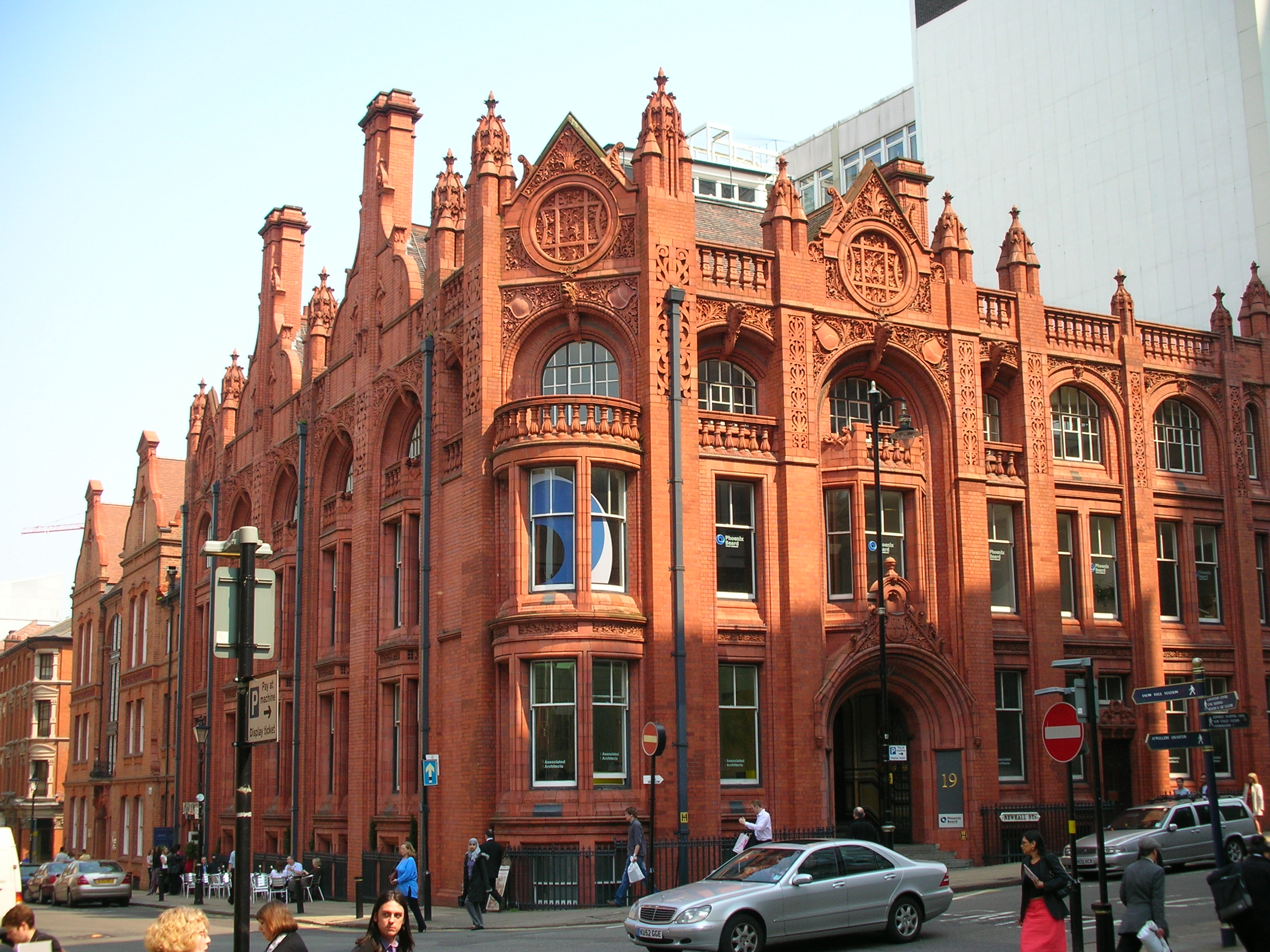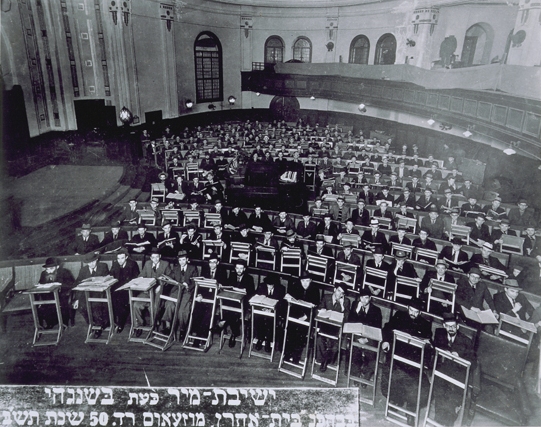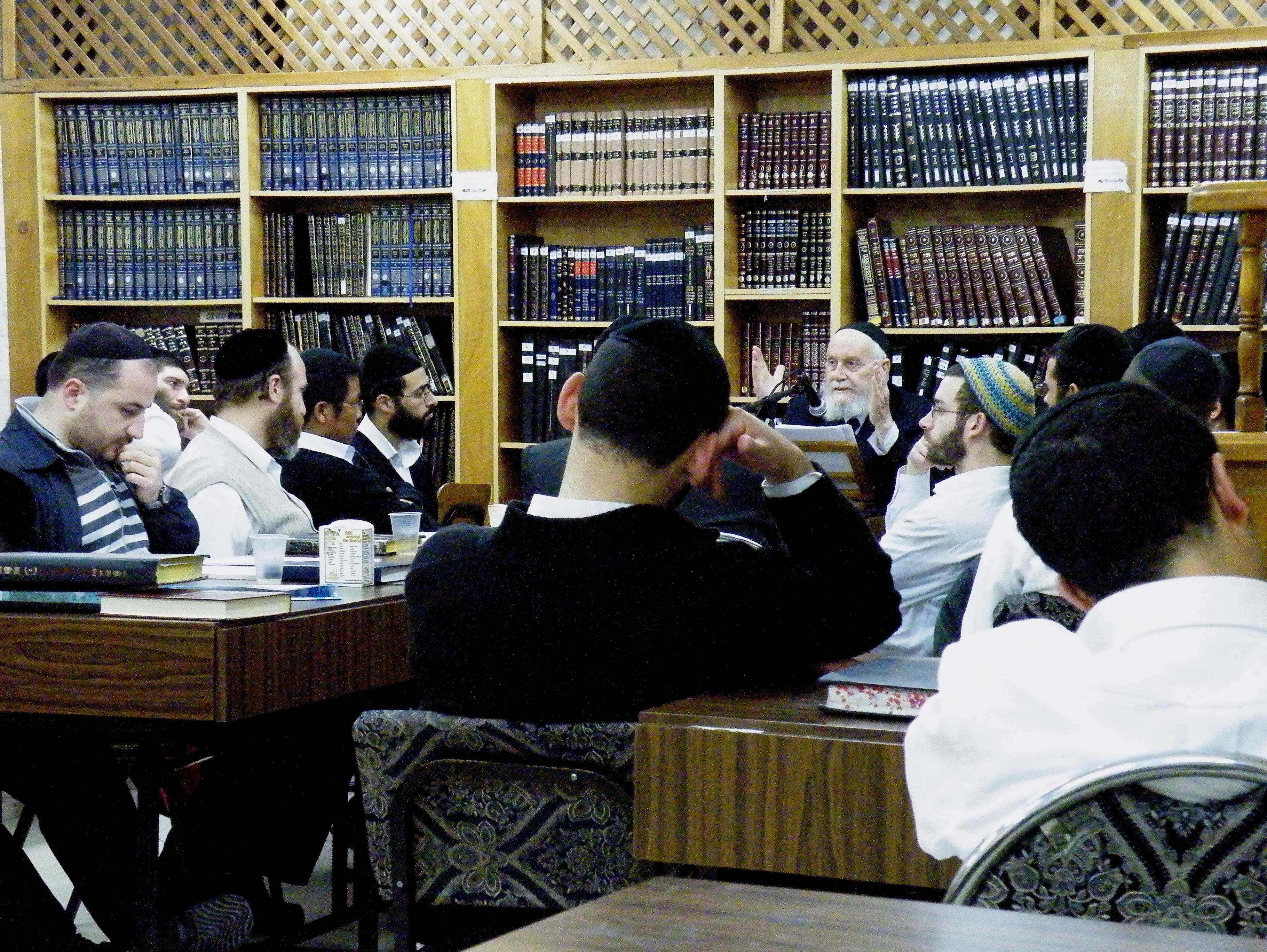|
Sunderland Yeshiva
The Sunderland Talmudical College (), popularly known as Sunderland Yeshiva, is a yeshiva located in Gateshead, United Kingdom. , the student body numbers approximately 100. Students are mainly English; however, there are also students from Switzerland, Belgium and the USA. History The yeshiva was founded in the city of Sunderland in the United Kingdom in October 1946 by Rabbi Aryeh Leib Grossnass and Rabbi Zushe Waltner at the initiative of Rabbi Eliyahu Eliezer Dessler. It was originally located at 2 Kensington Esplanade. The first students were approximately 30 former yeshiva students from displaced persons camps. In the 1950s, the yeshiva accepted several students from Morocco, which was subsequently followed in the coming years by other students from North Africa. In November 1952 the yeshiva moved to 1 The Cedars Road, Sunderland. It re-located to Gateshead in June 1988, but kept its original name. In 2021, following a successful matching campaign, the yeshiva exten ... [...More Info...] [...Related Items...] OR: [Wikipedia] [Google] [Baidu] |
Gateshead
Gateshead () is a town in the Gateshead Metropolitan Borough of Tyne and Wear, England. It is on the River Tyne's southern bank. The town's attractions include the twenty metre tall Angel of the North sculpture on the town's southern outskirts, The Glasshouse International Centre for Music and the Baltic Centre for Contemporary Art. The town shares the Gateshead Millennium Bridge, Millennium Bridge, Tyne Bridge and multiple other bridges with Newcastle upon Tyne. Historic counties of England, Historically part of County Durham, under the Local Government Act 1888 the town was made a county borough, meaning it was administered independently of the county council. In the 2021 United Kingdom census, 2021 Census, the town had a population of 196,151. Etymology Gateshead is first mentioned in Latin translation in Bede, Bede's ''Ecclesiastical History of the English People'' as ''ad caput caprae'' ("at the goat's head"). This interpretation is consistent with the later English attes ... [...More Info...] [...Related Items...] OR: [Wikipedia] [Google] [Baidu] |
Dormitory
A dormitory (originated from the Latin word ''dormitorium'', often abbreviated to dorm), also known as a hall of residence, a residence hall (often abbreviated to halls), or a hostel, is a building primarily providing sleeping and residential quarters for large numbers of people such as boarding school, college or university students. In some countries, it can also refer to a room containing several beds accommodating people. Terminology Dormitory is sometimes abbreviated to "dorm". In the UK, the word dormitory means a room (rather than a building) containing several beds accommodating unrelated people. This arrangement exists typically for pupils at boarding schools, travellers and military personnel, but is almost entirely unknown for university students. Student housing is normally referred to as "halls" or "halls of residence", or "colleges" in universities with residential colleges. A building providing sleeping and residential quarters for large numbers of people may als ... [...More Info...] [...Related Items...] OR: [Wikipedia] [Google] [Baidu] |
Architectural Terracotta
Architectural terracotta refers to a fired mixture of clay and water that can be used in a non-structural, semi-structural, or structural capacity on the exterior or interior of a building. Terracotta is an ancient building material that translates from Latin as "wikt:terracotta, baked earth". Some architectural terracotta is stronger than stoneware. It can be unglazed, painted, slip glazed, or Glazed architectural terra-cotta, glazed. Usually solid in earlier uses, in most cases from the 19th century onwards each piece of terracotta is composed of a hollow clay web enclosing a void space or cell. The cell can be installed in compression with Mortar (masonry), mortar or hung with metal anchors; such cells are often partially backfilled with mortar. Terracotta can be used together with brick, for ornamental areas; if the source of the clay is the same they can be made to harmonize, or if different to contrast. It is often a cladding over a different structural material. Hist ... [...More Info...] [...Related Items...] OR: [Wikipedia] [Google] [Baidu] |
Gable Stone
Gable stones () are carved and often colourfully painted stone tablets, which are set into the walls of buildings, usually at about 4 metres from the ground. They serve both to identify and embellish the building. They are also called "stone tablets" by the Rijksmuseum, which sometimes appends "from a facade". A "wall stone" is another suggested translation from the Dutch term. The content of gable stones may explain something about the house's owner and are a feature of the urban fabric of Amsterdam. Some 2,500 of these stones can still be found in the Netherlands, of which around 850 are in Amsterdam and 250 in Maastricht, while others are also found in cities such as Brussels, Liège, Lille, Oslo, Bergen, Munich, Copenhagen, Bucharest, Zürich, Stockholm and Warsaw. History Gable stones came into use in the 16th century, in the days before house numbers, taking over from hanging signs as a way of simultaneously and memorably identifying and adorning a house. The tradition is ... [...More Info...] [...Related Items...] OR: [Wikipedia] [Google] [Baidu] |
Welsh Slate
The existence of a slate industry in Wales is attested since the Roman period, when slate was used to roof the fort at Segontium, now Caernarfon. The slate industry grew slowly until the early 18th century, then rapidly during the Industrial Revolution in Wales until the late 19th century, at which time the most important slate producing areas were in northwest Wales. These sites included the Penrhyn Quarry near Bethesda, the Dinorwic Quarry near Llanberis, the Nantlle Valley quarries, and Blaenau Ffestiniog, where the slate was mined rather than quarried. Penrhyn and Dinorwig were the two largest slate quarries in the world, and the Oakeley mine at Blaenau Ffestiniog was the largest slate mine in the world. Slate is mainly used for roofing, but is also produced as thicker slab for a variety of uses including flooring, worktops, headstones as well as high quality surfaces for games such as shove ha'penny, snooker and billiards.Lindsay p. 133 Up to the end of the 18th cent ... [...More Info...] [...Related Items...] OR: [Wikipedia] [Google] [Baidu] |
Yechezkel Levenstein
Rabbi Yechezkel Levenstein () known as Reb Chatzkel, (1885 – 18 Adar (11 or 12 March) 1974), was the mashgiach ruchani of the Mir Yeshiva, in Mir, Belarus and during the yeshiva's escape to Lithuania and on to Shanghai due to the invasion of Poland by Nazi Germany in World War II. He was a leader of several yeshivas in Europe, the United States, and Israel. Biography Levenstein was born in Warsaw (5656) His mother, Zlota, died when he was five years old; his father, Yehuda, subsequently remarried. He studied for years in the yeshiva in Łomża, influenced by the mussar movement, then in Raduń Yeshiva under the Chofetz Chaim and Rabbi Yeruchom Levovitz, and finally in the Kelm Talmud Torah. His wife was named Chaya. From 5695 (1935), for about 2 years"When Reb Yeruchom passed away (on the eighteenth of Sivan 5697) however, the heads of the yeshiva asked Reb Chatzkel if he would agree to return ..." he was the mashgiach of Yeshivas Lomza in Petach Tikvah. Shanghai News ... [...More Info...] [...Related Items...] OR: [Wikipedia] [Google] [Baidu] |
Shiur
A shiur (, , ; , ) is a lecture given any Torah-related topic of study, such as Gemara, Mishnah, ''Halakha'' (Jewish law), or Tanakh (Hebrew Bible), usually given in a yeshiva, though commonly in other Jewish communal settings. History The Hebrew term שיעור ("designated amount") came to refer to a portion of Judaic text arranged for study on a particular occasion, such as a yahrzeit, the dedication of a new home, or the evening of a holiday, and then to a public reading and explanation of the same. The act of teaching and studying these texts at the designated time was known as ''shiur lernen'' (); by synecdoche, the act itself became known as ''shiur''. These shiurim would be attended by all classes of people; it was traditional for learned attendees to engage the lecturer in continuous discussion, and for the larger lay audience to listen intently. Concurrently, in the yeshiva-setting it came to refer to the daily study quotient for students, and then to the le ... [...More Info...] [...Related Items...] OR: [Wikipedia] [Google] [Baidu] |
Masekhet
A (, Sephardic: , Ashkenazic: ; plural ) is an organizational element of Talmudic literature that systematically examines a subject, referred to as a tractate in English. A tractate/ consists of chapters (; singular: or ). Etymology The word – in its pausal form, () – appears in the Hebrew Bible denoting web or texture (). The plain Hebrew meaning of the word is the warp and weft used in weaving. By extension, the word has been used to refer to a work of in-depth examination of a topic comprising discussions, research and conclusions. It refers in particular to the sections of the Mishnah, Tosefta, Beraita, and Gemara of the Babylonian and Yerushalaim Talmuds. Usage The "major" tractates, those of the Mishnah itself, are organized into six groups, called ''sedarim'', while the minor tractates, which were not canonized in the Mishnah, stand alone. The Mishnah comprises sixty-three tractates, each of which is divided into chapters and paragraphs. The same applie ... [...More Info...] [...Related Items...] OR: [Wikipedia] [Google] [Baidu] |
Talmud
The Talmud (; ) is the central text of Rabbinic Judaism and the primary source of Jewish religious law (''halakha'') and Jewish theology. Until the advent of Haskalah#Effects, modernity, in nearly all Jewish communities, the Talmud was the centerpiece of Jewish culture, Jewish cultural life and was foundational to "all Jewish thought and aspirations", serving also as "the guide for the daily life" of Jews. The Talmud includes the teachings and opinions of thousands of rabbis on a variety of subjects, including halakha, Jewish ethics, Jewish philosophy, philosophy, Jewish customs, customs, Jewish history, history, and Jewish folklore, folklore, and many other topics. The Talmud is a commentary on the Mishnah. This text is made up of 63 Masekhet, tractates, each covering one subject area. The language of the Talmud is Jewish Babylonian Aramaic. Talmudic tradition emerged and was compiled between the destruction of the Second Temple in 70 CE and the Arab conquest in the early seve ... [...More Info...] [...Related Items...] OR: [Wikipedia] [Google] [Baidu] |
Mashgiach Ruchani
A mashgiach ruchani (; pl., ''mashgichim ruchani'im''), sometimes mashgiach for short, is a spiritual supervisor or guide. They are usually a rabbi who has an official position within a yeshiva and is responsible for the non-academic areas of yeshiva students' lives.''HaRav Schach: Conversations: Stories to Inspire the Yeshiva World''. Elʻazar Menaḥem Man Shakh - 2004 p52: "Speaking about the position of Mashgiach Ruchani (Spiritual Supervisor) in a yeshiva, Rav Schach used to say that while it goes without saying that the Mashgiach must be a God-fearing man, and a person capable of inspiring others with his ..." Description The position of mashgiach ruchani arose with the establishment of the modern "Litvaks, Lithuanian-style" Musar movement, musar yeshivas. The prototype of this new type of rabbinical leader and educator was Rabbi Nosson Tzvi Finkel (Slabodka), Nosson Tzvi Finkel (1849-1927) known as the Alter (elder) of the Slabodka yeshiva, Yeshivas Knesses Yisrael (Slabodka ... [...More Info...] [...Related Items...] OR: [Wikipedia] [Google] [Baidu] |
Sho'el U'meishiv
A yeshiva (; ; pl. , or ) is a traditional Jewish education, Jewish educational institution focused on the study of Rabbinic literature, primarily the Talmud and halacha (Jewish law), while Torah and Jewish philosophy are studied in parallel. The studying is usually done through daily ''Shiur (Torah), shiurim'' (lectures or classes) as well as in study pairs called ''chavrusas'' (Aramaic language, Aramaic for 'friendship' or 'companionship'). ''Chavrusa''-style learning is one of the unique features of the yeshiva. In the United States and Israel, different levels of yeshiva education have different names. In the U.S., elementary-school students enroll in a ''cheder'', post-Bar and Bat Mitzvah, bar mitzvah-age students learn in a ''mesivta'', and undergraduate-level students learn in a ''beit midrash'' or ''yeshiva gedola'' (). In Israel, elementary-school students enroll in a Talmud Torah or ''cheder'', post-bar mitzvah-age students learn in a ''yeshiva ketana'' (), and ... [...More Info...] [...Related Items...] OR: [Wikipedia] [Google] [Baidu] |





